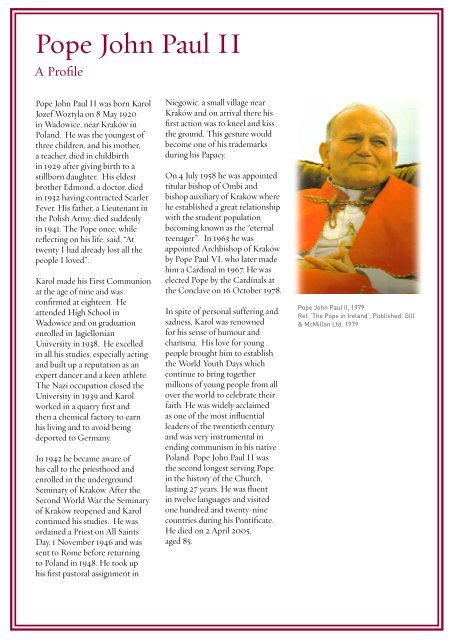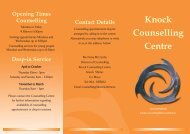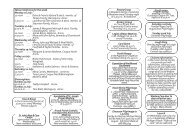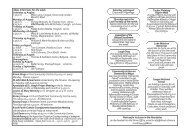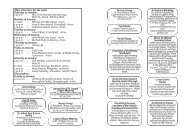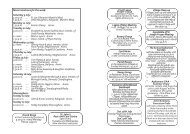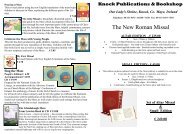Pope John Paul II was born Karol Jozef Woztyla on 8 ... - Knock Shrine
Pope John Paul II was born Karol Jozef Woztyla on 8 ... - Knock Shrine
Pope John Paul II was born Karol Jozef Woztyla on 8 ... - Knock Shrine
You also want an ePaper? Increase the reach of your titles
YUMPU automatically turns print PDFs into web optimized ePapers that Google loves.
<str<strong>on</strong>g>Pope</str<strong>on</strong>g> <str<strong>on</strong>g>John</str<strong>on</strong>g> <str<strong>on</strong>g>Paul</str<strong>on</strong>g> <str<strong>on</strong>g>II</str<strong>on</strong>g><br />
A Profile<br />
<str<strong>on</strong>g>Pope</str<strong>on</strong>g> <str<strong>on</strong>g>John</str<strong>on</strong>g> <str<strong>on</strong>g>Paul</str<strong>on</strong>g> <str<strong>on</strong>g>II</str<strong>on</strong>g> <str<strong>on</strong>g>was</str<strong>on</strong>g> <str<strong>on</strong>g>born</str<strong>on</strong>g> <str<strong>on</strong>g>Karol</str<strong>on</strong>g><br />
<str<strong>on</strong>g>Jozef</str<strong>on</strong>g> <str<strong>on</strong>g>Woztyla</str<strong>on</strong>g> <strong>on</strong> 8 May 1920<br />
in Wadowice, near Kraków in<br />
Poland. He <str<strong>on</strong>g>was</str<strong>on</strong>g> the youngest of<br />
three children, and his mother,<br />
a teacher, died in childbirth<br />
Niegowic, a small village near<br />
Kraków and <strong>on</strong> arrival there his<br />
first acti<strong>on</strong> <str<strong>on</strong>g>was</str<strong>on</strong>g> to kneel and kiss<br />
the ground. This gesture would<br />
become <strong>on</strong>e of his trademarks<br />
during his Papacy.<br />
in 1929 after giving birth to a<br />
still<str<strong>on</strong>g>born</str<strong>on</strong>g> daughter. His eldest<br />
brother Edm<strong>on</strong>d, a doctor, died<br />
in 1932 having c<strong>on</strong>tracted Scarlet<br />
Fever. His father, a Lieutenant in<br />
the Polish Army, died suddenly<br />
in 1941. The <str<strong>on</strong>g>Pope</str<strong>on</strong>g> <strong>on</strong>ce, while<br />
reflecting <strong>on</strong> his life, said, “At<br />
twenty I had already lost all the<br />
people I loved”.<br />
On 4 July 1958 he <str<strong>on</strong>g>was</str<strong>on</strong>g> appointed<br />
titular bishop of Ombi and<br />
bishop auxiliary of Kraków where<br />
he established a great relati<strong>on</strong>ship<br />
with the student populati<strong>on</strong><br />
becoming known as the “eternal<br />
teenager”. In 1963 he <str<strong>on</strong>g>was</str<strong>on</strong>g><br />
appointed Archbishop of Kraków<br />
by <str<strong>on</strong>g>Pope</str<strong>on</strong>g> <str<strong>on</strong>g>Paul</str<strong>on</strong>g> VI, who later made<br />
him a Cardinal in 1967. He <str<strong>on</strong>g>was</str<strong>on</strong>g><br />
<str<strong>on</strong>g>Karol</str<strong>on</strong>g> made his First Communi<strong>on</strong><br />
at the age of nine and <str<strong>on</strong>g>was</str<strong>on</strong>g><br />
c<strong>on</strong>firmed at eighteen. He<br />
attended High School in<br />
Wadowice and <strong>on</strong> graduati<strong>on</strong><br />
enrolled in Jagiell<strong>on</strong>ian<br />
University in 1938. He excelled<br />
in all his studies, especially acting<br />
and built up a reputati<strong>on</strong> as an<br />
expert dancer and a keen athlete.<br />
The Nazi occupati<strong>on</strong> closed the<br />
University in 1939 and <str<strong>on</strong>g>Karol</str<strong>on</strong>g><br />
worked in a quarry first and<br />
then a chemical factory to earn<br />
his living and to avoid being<br />
deported to Germany.<br />
In 1942 he became aware of<br />
his call to the priesthood and<br />
enrolled in the underground<br />
Seminary of Kraków. After the<br />
Sec<strong>on</strong>d World War the Seminary<br />
of Kraków reopened and <str<strong>on</strong>g>Karol</str<strong>on</strong>g><br />
c<strong>on</strong>tinued his studies. He <str<strong>on</strong>g>was</str<strong>on</strong>g><br />
ordained a Priest <strong>on</strong> All Saints<br />
Day, 1 November 1946 and <str<strong>on</strong>g>was</str<strong>on</strong>g><br />
sent to Rome before returning<br />
to Poland in 1948. He took up<br />
his first pastoral assignment in<br />
elected <str<strong>on</strong>g>Pope</str<strong>on</strong>g> by the Cardinals at<br />
the C<strong>on</strong>clave <strong>on</strong> 16 October 1978.<br />
In spite of pers<strong>on</strong>al suffering and<br />
sadness, <str<strong>on</strong>g>Karol</str<strong>on</strong>g> <str<strong>on</strong>g>was</str<strong>on</strong>g> renowned<br />
for his sense of humour and<br />
charisma. His love for young<br />
people brought him to establish<br />
the World Youth Days which<br />
c<strong>on</strong>tinue to bring together<br />
milli<strong>on</strong>s of young people from all<br />
over the world to celebrate their<br />
faith. He <str<strong>on</strong>g>was</str<strong>on</strong>g> widely acclaimed<br />
as <strong>on</strong>e of the most influential<br />
leaders of the twentieth century<br />
and <str<strong>on</strong>g>was</str<strong>on</strong>g> very instrumental in<br />
ending communism in his native<br />
Poland. <str<strong>on</strong>g>Pope</str<strong>on</strong>g> <str<strong>on</strong>g>John</str<strong>on</strong>g> <str<strong>on</strong>g>Paul</str<strong>on</strong>g> <str<strong>on</strong>g>II</str<strong>on</strong>g> <str<strong>on</strong>g>was</str<strong>on</strong>g><br />
the sec<strong>on</strong>d l<strong>on</strong>gest serving <str<strong>on</strong>g>Pope</str<strong>on</strong>g><br />
in the history of the Church,<br />
lasting 27 years. He <str<strong>on</strong>g>was</str<strong>on</strong>g> fluent<br />
in twelve languages and visited<br />
<strong>on</strong>e hundred and twenty-nine<br />
countries during his P<strong>on</strong>tificate.<br />
He died <strong>on</strong> 2 April 2005,<br />
aged 85.<br />
<str<strong>on</strong>g>Pope</str<strong>on</strong>g> <str<strong>on</strong>g>John</str<strong>on</strong>g> <str<strong>on</strong>g>Paul</str<strong>on</strong>g> <str<strong>on</strong>g>II</str<strong>on</strong>g>, 1979<br />
Ref. ‘The <str<strong>on</strong>g>Pope</str<strong>on</strong>g> in Ireland’, Published: Gill<br />
& McMillan Ltd. 1979
<str<strong>on</strong>g>Pope</str<strong>on</strong>g> <str<strong>on</strong>g>John</str<strong>on</strong>g> <str<strong>on</strong>g>Paul</str<strong>on</strong>g> <str<strong>on</strong>g>II</str<strong>on</strong>g><br />
Visit to <strong>Knock</strong> <strong>Shrine</strong><br />
On Sunday 30 September 1979,<br />
a wet and misty day, over half a<br />
milli<strong>on</strong> people welcomed <str<strong>on</strong>g>Pope</str<strong>on</strong>g><br />
<str<strong>on</strong>g>John</str<strong>on</strong>g> <str<strong>on</strong>g>Paul</str<strong>on</strong>g> <str<strong>on</strong>g>II</str<strong>on</strong>g> to <strong>Knock</strong>. His<br />
helicopter touched down <strong>on</strong> the<br />
east side of the Basilica at 3.20pm,<br />
slightly later than anticipated. As<br />
he alighted from the helicopter<br />
he <str<strong>on</strong>g>was</str<strong>on</strong>g> greeted by Archbishop<br />
Joseph Cunnane and M<strong>on</strong>signor<br />
James Horan. The <str<strong>on</strong>g>Pope</str<strong>on</strong>g> <str<strong>on</strong>g>was</str<strong>on</strong>g><br />
then escorted al<strong>on</strong>g a specially<br />
c<strong>on</strong>structed ramp to the Basilica<br />
rooftop where he raised his<br />
hands in greeting to the waiting<br />
pilgrims.<br />
Everywhere in the Basilica <str<strong>on</strong>g>was</str<strong>on</strong>g><br />
alive with excitement as pilgrims,<br />
Accompanied by Archbishop Cunnane and Cardinal O’Fiaich, the Holy Father<br />
vested in the inner sacristy of the Basilica, assisted by Masters of Cerem<strong>on</strong>ies,<br />
Cardinal Noe, and Fr. Joseph Quinn of the Tuam Dioceses.<br />
many of them ill and disabled,<br />
awaited their first sighting of<br />
the Holy Father. As he walked<br />
around the altar in the Liturgical<br />
processi<strong>on</strong>, he blessed and<br />
greeted individual pilgrims before<br />
ascending to the altar. He gave a<br />
special address for sick people and<br />
also for the assembled Stewards<br />
and Handmaids of the <strong>Knock</strong><br />
<strong>Shrine</strong> Society.<br />
The Liturgical processi<strong>on</strong> then<br />
moved to the open-air sanctuary<br />
for mass. The Holy Father<br />
opened his homily by reciting<br />
the Hail Mary in Irish and then<br />
addressed the crowd with his now<br />
famous words ‘Here I am at the<br />
goal of my journey to Ireland –<br />
the <strong>Shrine</strong> of Our Lady at <strong>Knock</strong>’.<br />
His homily lasted for forty-two<br />
minutes after which he anointed<br />
twelve people including 92-<br />
year-old Mrs Catherine Horan,<br />
mother of M<strong>on</strong>signor Horan.<br />
The Offertory Processi<strong>on</strong> gifts<br />
included water from the Holy<br />
Well of Lispatrick in <strong>Knock</strong><br />
parish, a st<strong>on</strong>e from Croagh<br />
Patrick and flowers carried by<br />
local first communicants, Siobhán<br />
Geraghty and Michael <str<strong>on</strong>g>John</str<strong>on</strong>g>st<strong>on</strong>.<br />
One hundred and five people<br />
representing the Tuam Diocese<br />
received Holy Communi<strong>on</strong> from<br />
the Holy Father. One thousand<br />
Ministers of the Eucharist<br />
distributed Holy Communi<strong>on</strong> to<br />
the C<strong>on</strong>gregati<strong>on</strong>.<br />
At the end of Mass the Holy<br />
Father announced that the<br />
“Church of Our Lady Queen of<br />
Ireland” would be designated the<br />
title “Basilica of Our Lady Queen<br />
of Ireland.” He also presented a<br />
Golden Rose symbolic of the high<br />
status of <strong>Knock</strong> <strong>Shrine</strong>.<br />
The Holy Father then proceeded<br />
to the Appariti<strong>on</strong> Chapel where<br />
he knelt and prayed in silence<br />
after which he blessed the statues<br />
depicting the Appariti<strong>on</strong> and lit<br />
the Family Prayer Candle. Due<br />
to fading light it <str<strong>on</strong>g>was</str<strong>on</strong>g> decided that<br />
the <str<strong>on</strong>g>Pope</str<strong>on</strong>g> would not travel am<strong>on</strong>g<br />
the pilgrims as originally planned<br />
and so he <str<strong>on</strong>g>was</str<strong>on</strong>g> then driven to the<br />
helicopter pad for departure at<br />
7pm.<br />
Sunday 30 September 1979, when<br />
<str<strong>on</strong>g>Pope</str<strong>on</strong>g> <str<strong>on</strong>g>John</str<strong>on</strong>g> <str<strong>on</strong>g>Paul</str<strong>on</strong>g> <str<strong>on</strong>g>II</str<strong>on</strong>g> visited <strong>Knock</strong>,<br />
<str<strong>on</strong>g>was</str<strong>on</strong>g> the single most significant<br />
occasi<strong>on</strong> in the history of the<br />
<strong>Shrine</strong> since the Appariti<strong>on</strong> of<br />
1879.
<str<strong>on</strong>g>Pope</str<strong>on</strong>g> <str<strong>on</strong>g>John</str<strong>on</strong>g> <str<strong>on</strong>g>Paul</str<strong>on</strong>g> <str<strong>on</strong>g>II</str<strong>on</strong>g><br />
Preparati<strong>on</strong>s for Visit to <strong>Knock</strong><br />
In 1964, Mrs. Judy Coyne (<strong>Knock</strong><br />
<strong>Shrine</strong> Society) <strong>on</strong> reading of<br />
the visit of <str<strong>on</strong>g>Pope</str<strong>on</strong>g> <str<strong>on</strong>g>Paul</str<strong>on</strong>g> VI to<br />
Bethlehem, w<strong>on</strong>dered if it would<br />
be possible that <strong>on</strong>e day he would<br />
visit <strong>Knock</strong> With the centenary<br />
of the <strong>Knock</strong> Appariti<strong>on</strong> still<br />
fifteen years away, she formed<br />
the idea that this would be the<br />
ideal occasi<strong>on</strong> for such a visit. In<br />
1978 the Episcopal C<strong>on</strong>ference<br />
in Maynooth issued an official<br />
invitati<strong>on</strong> to the newly elected<br />
<str<strong>on</strong>g>Pope</str<strong>on</strong>g> to visit Ireland. On 21 July<br />
1979 it <str<strong>on</strong>g>was</str<strong>on</strong>g> officially announced<br />
that <str<strong>on</strong>g>Pope</str<strong>on</strong>g> <str<strong>on</strong>g>John</str<strong>on</strong>g> <str<strong>on</strong>g>Paul</str<strong>on</strong>g> <str<strong>on</strong>g>II</str<strong>on</strong>g> would visit<br />
Ireland. <strong>Knock</strong> <strong>Shrine</strong> <str<strong>on</strong>g>was</str<strong>on</strong>g> to be<br />
‘the goal of his journey’.<br />
<str<strong>on</strong>g>Pope</str<strong>on</strong>g> <str<strong>on</strong>g>John</str<strong>on</strong>g> <str<strong>on</strong>g>Paul</str<strong>on</strong>g> <str<strong>on</strong>g>II</str<strong>on</strong>g>, 1979<br />
Ref. ‘The <str<strong>on</strong>g>Pope</str<strong>on</strong>g> in Ireland’, Published: Gill & McMillan Ltd. 1979<br />
The Nati<strong>on</strong>al Co-ordinati<strong>on</strong><br />
Committee <str<strong>on</strong>g>was</str<strong>on</strong>g> in charge of the<br />
majority of arrangements for<br />
the Papal Visit to Ireland and<br />
they worked closely with the<br />
Archbishop of Tuam, Dr. Joseph<br />
Cunnane, who <str<strong>on</strong>g>was</str<strong>on</strong>g> in charge of<br />
operati<strong>on</strong>s for <strong>Knock</strong>. With <strong>on</strong>ly<br />
nine weeks to prepare, there <str<strong>on</strong>g>was</str<strong>on</strong>g><br />
much work to be d<strong>on</strong>e. Parish<br />
Priest of <strong>Knock</strong>, M<strong>on</strong>signor<br />
Horan, priests from the diocese,<br />
lay people and countless<br />
volunteers all became involved<br />
in committees organising every<br />
detail from transport, catering,<br />
security, media and decorating to<br />
liturgy, music and ministers. Fr.<br />
Tom Shann<strong>on</strong> (R.I.P.), secretary<br />
to Archbishop Cunnane <str<strong>on</strong>g>was</str<strong>on</strong>g><br />
the general co-coordinator for<br />
all committees. Some of the<br />
other committee chairpeople<br />
included: Fr. Joseph Quinn<br />
(now M<strong>on</strong>signor), Liturgical<br />
Committee; Fr. Frank Fahey,<br />
Medical Services Committee;<br />
Michael O’Malley, Mayo Co.<br />
Manager, Access and Transport<br />
Committee; Fr. P. V. O’ Brien,<br />
Communicati<strong>on</strong>s Committee.<br />
In order to accommodate<br />
the estimated half a milli<strong>on</strong><br />
attendance, a thirty-seven acre<br />
site <str<strong>on</strong>g>was</str<strong>on</strong>g> cleared and divided<br />
into corrals accommodating<br />
twelve thousand people, each<br />
to have its own First Aid post.<br />
Two helicopters and numerous<br />
ambulances would be <strong>on</strong> stand-by<br />
for emergencies. New roads were<br />
laid down for the ‘<str<strong>on</strong>g>Pope</str<strong>on</strong>g>mobile’.<br />
No cars were to be allowed into<br />
the village for the durati<strong>on</strong> so<br />
lands <strong>on</strong> the approach roads to<br />
<strong>Knock</strong> were to be opened up to<br />
facilitate parking.<br />
An automatic teleph<strong>on</strong>e exchange,<br />
press-centre, darkrooms, and<br />
additi<strong>on</strong>al ph<strong>on</strong>e lines were<br />
installed to facilitate media<br />
coverage and communicati<strong>on</strong>s.<br />
The Army, Gardaí, County<br />
Council, Civil Defence, Order of<br />
Malta, Red Cross, <strong>Knock</strong> <strong>Shrine</strong><br />
Handmaids and Stewards were all<br />
to be involved in crowd security.<br />
Only people, including officiating<br />
priests, sick people etc., with<br />
official identificati<strong>on</strong> cards issued<br />
by the Gardaí would be allowed<br />
access to special areas during the<br />
visit.<br />
<strong>Knock</strong> <strong>Shrine</strong> and village also had<br />
to be prepared aesthetically for<br />
the <str<strong>on</strong>g>Pope</str<strong>on</strong>g>’s visit. One of the most<br />
important tasks to be undertaken<br />
<str<strong>on</strong>g>was</str<strong>on</strong>g> the design and erecti<strong>on</strong> of<br />
an outdoor Papal altar. The altar,<br />
featuring an image of the Last<br />
Supper, came from the Cathedral<br />
Church of St. Mel’s in L<strong>on</strong>gford.<br />
A large cross <str<strong>on</strong>g>was</str<strong>on</strong>g> also erected as a<br />
permanent commemorati<strong>on</strong> of the<br />
visit.<br />
By Sunday 30 September,<br />
<strong>Knock</strong> <strong>Shrine</strong> and grounds were<br />
transformed. Pilgrims had begun<br />
to arrive the afterno<strong>on</strong> before and<br />
by nightfall thousands of people<br />
had assembled to await the arrival<br />
of <str<strong>on</strong>g>Pope</str<strong>on</strong>g> <str<strong>on</strong>g>John</str<strong>on</strong>g> <str<strong>on</strong>g>Paul</str<strong>on</strong>g> <str<strong>on</strong>g>II</str<strong>on</strong>g> to <strong>Knock</strong> –<br />
an event never to be forgotten.


